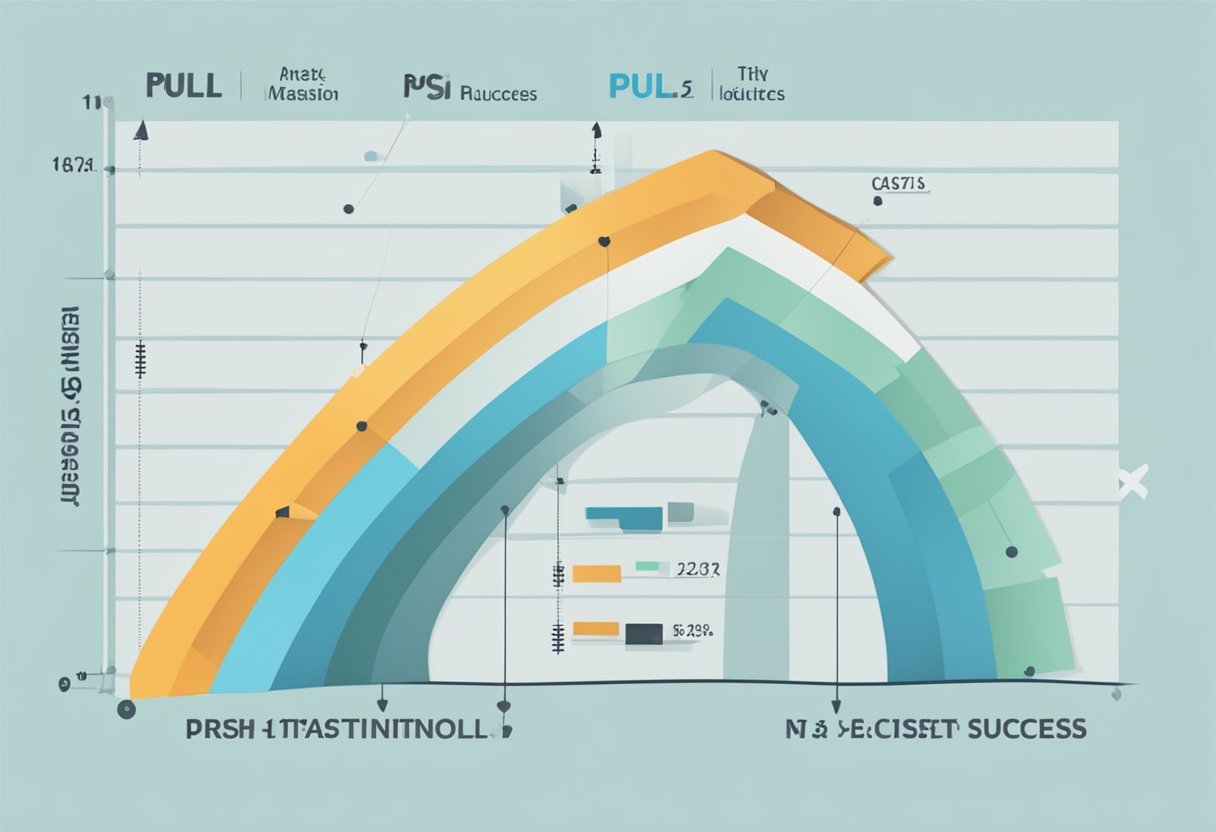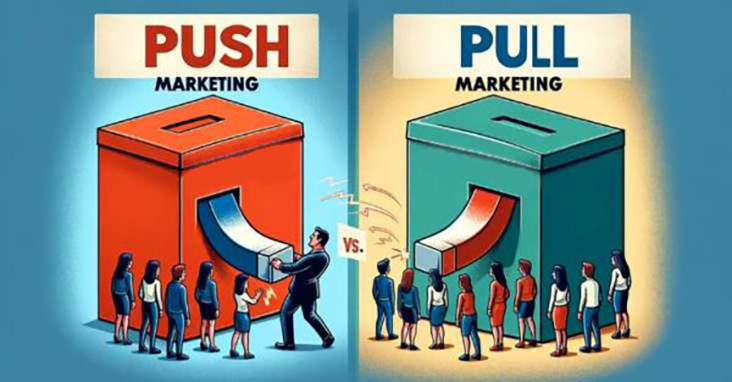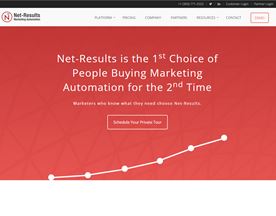What are they key differences between push vs pull marketing? Push marketing directly promotes products to consumers, using tactics like advertising and sales. Pull marketing creates demand, drawing consumers in through strategies like SEO and content marketing.
Push vs pull marketing is an ongoing debate in the world of marketing. While both strategies aim to attract and retain customers, they differ in their approach. Push marketing, also known as outbound marketing, involves pushing products or services to customers through advertising, sales promotions, and other forms of communication. On the other hand, pull marketing, also known as inbound marketing, involves creating valuable content that attracts customers to your brand.

Understanding the differences between push and pull marketing is crucial for businesses looking to maximize their marketing efforts. Push marketing is often associated with traditional advertising methods, such as TV commercials, billboards, and direct mail. While these methods can be effective in reaching a large audience, they can also be expensive and intrusive. In contrast, pull marketing focuses on creating content that customers find useful and engaging, such as blog posts, social media updates, and informative videos.
The role of social media has also changed the marketing landscape, making it easier for businesses to implement pull marketing strategies. Social media platforms like Facebook, Instagram, and Twitter provide businesses with an opportunity to engage with their target audience and build relationships with customers. By creating valuable content that resonates with their audience, businesses can attract new customers and retain existing ones.
Key Takeaways
- Push marketing involves pushing products or services to customers through advertising and sales promotions, while pull marketing involves creating valuable content that attracts customers to your brand.
- Social media has made it easier for businesses to implement pull marketing strategies by providing an opportunity to engage with their target audience and build relationships with customers.
- By creating valuable content that resonates with their audience, businesses can attract new customers and retain existing ones.
Understanding Push Marketing
Push marketing is a promotional strategy that involves pushing a product or service towards the target audience. It is a proactive approach where the marketer tries to reach out to the customers and convince them to make a purchase. In this section, we will discuss the various aspects of push marketing.
Definition of Push Marketing
Push marketing is a type of outbound marketing that involves promoting a product or service to a target audience. It is a proactive approach where the marketer tries to reach out to the customers and convince them to make a purchase. The primary goal of push marketing is to increase demand for the product or service and drive immediate conversions.
Push Marketing Channels
Push marketing channels include various advertising and sales techniques that are aimed at promoting a product or service. Some of the most common push marketing channels include billboards, direct mail, commercials, flyers, telemarketing, and trade shows. These channels are designed to reach out to the target audience and persuade them to make a purchase.
Advantages and Disadvantages
Push marketing has several advantages and disadvantages. Some of the advantages of push marketing include immediate conversions, greater control over the message, and the ability to reach a large audience quickly. However, push marketing can be expensive, and it may not always be effective in reaching the target audience. Additionally, push marketing can be seen as intrusive and annoying by some customers, which can damage the brand’s reputation.
In conclusion, push marketing is a proactive approach where the marketer tries to reach out to the customers and convince them to make a purchase. It involves various advertising and sales techniques that are aimed at promoting a product or service. While push marketing has several advantages, it also has some disadvantages, which should be carefully considered before implementing this strategy.
Understanding Pull Marketing
Definition of Pull Marketing
Pull marketing is a marketing strategy that involves attracting potential customers towards a brand or product by creating content that is of interest to them. This type of marketing relies on the audience’s interest in the brand or product and their willingness to seek it out. The goal of pull marketing is to create a demand for a product or service by generating interest from the audience.
Pull Marketing Channels
There are several channels through which pull marketing can be executed. These channels include search engine optimization (SEO), inbound marketing, content marketing, social media marketing, blogs, blog posts, educational content, and Google Ads. These channels are used to increase the visibility of a brand or product, generate leads, and drive traffic to a website.
Advantages and Disadvantages
One of the advantages of pull marketing is that it is less intrusive than push marketing. It allows the audience to seek out the brand or product on their own terms, which can lead to a more positive perception of the brand. Additionally, pull marketing can be more cost-effective than push marketing, as it relies on the creation of content rather than paid advertising.
However, pull marketing can also be challenging, as it requires a significant investment in creating content that is of interest to the audience. It can also be difficult to measure the effectiveness of pull marketing, as it relies on the audience’s interest in the brand or product.
Overall, pull marketing can be an effective strategy for brands looking to create a demand for their products or services. By creating content that is of interest to the audience, brands can attract potential customers and generate leads.
The Role of Social Media
Social media has become an integral part of marketing strategies for businesses across industries. It has the potential to reach a large audience and engage with them in a personalized manner. Social media can be used for both push and pull marketing strategies.
Social Media in Push Marketing
Push marketing involves sending promotional messages to a target audience. Social media can be used to push marketing messages through sponsored posts, paid advertisements, and influencer marketing.
Social media platforms such as Facebook Ads allow businesses to create targeted ads based on audience demographics, interests, and behaviors. This enables businesses to reach their target audience with relevant marketing messages.
Influencer marketing on social media involves partnering with social media influencers who have a large following. These influencers can promote a business’s products or services to their followers, thereby increasing brand awareness and driving sales.
Social Media in Pull Marketing
Pull marketing involves creating content that attracts potential customers to a business’s website or social media page. Social media can be used to pull customers through organic content, such as posts, videos, and stories.
Social media platforms such as Instagram and TikTok allow businesses to create engaging content that can go viral. By creating content that resonates with their audience, businesses can attract new followers and increase engagement.
Social media marketing also involves engaging with followers through comments, direct messages, and live streams. This helps businesses build relationships with their audience and create a loyal customer base.
In conclusion, social media plays a crucial role in both push and pull marketing strategies. By leveraging social media platforms, businesses can reach a large audience, engage with them in a personalized manner, and drive sales.
Strategizing Marketing Efforts

Aligning Strategy with Business Goals
Before implementing any marketing strategy, it is important to align it with the overall business goals. The marketing strategy should be designed to support the sales goals of the business, whether it is increasing brand awareness, driving sales, or building brand loyalty.
To achieve this, businesses need to identify their target audience, understand their needs, and develop a clear value proposition. This will help them to create a marketing strategy that resonates with their target audience and drives results.
Balancing Push and Pull Tactics
Push and pull marketing strategies are two approaches that businesses can use to reach their target audience. Push marketing involves pushing products or services to the target audience through advertising, direct mail, and other promotional activities. Pull marketing, on the other hand, involves creating content that attracts the target audience to the business.
To strike a balance between push and pull tactics, businesses need to consider their target audience and the stage of the buyer’s journey they are in. For example, push tactics may be more effective for reaching new customers or generating leads, while pull tactics may be more effective for building brand loyalty and driving repeat business.
Digital marketing campaigns offer an opportunity to combine push and pull tactics in a single campaign. By using targeted advertising, businesses can push their products or services to their target audience while using content marketing to pull them in and build brand loyalty.
By carefully strategizing their marketing efforts, businesses can create a marketing strategy that supports their overall business goals and drives results.
Targeting the Right Audience

In marketing, it is crucial to target the right audience to achieve maximum effectiveness. Both push and pull marketing strategies require a clear understanding of the target audience, their needs, and preferences.
Identifying the Target Audience
Before implementing any marketing strategy, it is essential to identify the target audience. This involves understanding the demographics, psychographics, and behavior of the customers. This can be achieved through market research, surveys, and data analysis.
Once the target audience is identified, it is easier to tailor marketing messages to their needs and preferences. This helps to grab their attention and generate interest in the product or service being offered.
Customizing Messages for the Audience
Customizing messages for the target audience is crucial in both push and pull marketing strategies. In push marketing, it involves creating ads that are relevant to the target audience and placing them in locations where the audience is likely to see them.
In pull marketing, it involves creating content that is informative, relevant, and engaging to the target audience. This can be achieved through social media, blogs, and other digital marketing channels.
Overall, targeting the right audience is crucial in both push and pull marketing strategies. It requires a deep understanding of the customer base and their needs and preferences. By customizing messages to the target audience, it is possible to achieve maximum effectiveness in marketing efforts.
Building Brand and Customer Relationships

Building brand and customer relationships is a crucial aspect of marketing. It involves creating brand awareness, fostering brand loyalty, and developing long-term relationships with customers. In this section, we will discuss how push and pull marketing strategies can be used to achieve these goals.
Creating Brand Awareness
Push and pull marketing strategies can both be used to create brand awareness. Push marketing involves promoting a brand through direct advertising, sales promotions, and other forms of communication that are designed to push a product or service onto customers. Pull marketing, on the other hand, involves creating content that is designed to attract customers to a brand through search engine optimization, social media marketing, and other forms of content marketing.
Regardless of the strategy used, building brand awareness is important because it helps to establish credibility and trust with customers. By consistently promoting a brand, businesses can create a strong brand identity that customers will recognize and trust.
Fostering Brand Loyalty
Fostering brand loyalty is another important aspect of building brand and customer relationships. This involves creating a positive customer experience that encourages customers to continue doing business with a brand. Push and pull marketing strategies can both be used to foster brand loyalty.
Push marketing can be used to offer promotions and discounts to customers, which can help to encourage repeat business. Pull marketing, on the other hand, can be used to create content that is designed to engage customers and keep them coming back for more.
Developing Long-Term Relationships
Developing long-term relationships with customers is the ultimate goal of building brand and customer relationships. This involves creating a strong connection with customers that goes beyond just a single transaction. Push and pull marketing strategies can both be used to achieve this goal.
Push marketing can be used to offer personalized customer service and support, which can help to create a strong bond between a brand and its customers. Pull marketing, on the other hand, can be used to create content that is designed to educate and inform customers, which can help to build trust and credibility.
In conclusion, building brand and customer relationships is a critical aspect of marketing. Push and pull marketing strategies can both be used to achieve this goal by creating brand awareness, fostering brand loyalty, and developing long-term relationships with customers. By using these strategies effectively, businesses can establish credibility, build customer reviews, and create a strong brand identity that customers will recognize and trust.
Measuring Marketing Success

Analyzing Marketing Metrics
Measuring the success of marketing campaigns is essential to determine their effectiveness and make necessary adjustments. The metrics used to analyze marketing success depend on the type of campaign and its goals. For instance, if the goal is to increase brand awareness, metrics such as website traffic, social media engagement, and email open rates can be used to measure success.
On the other hand, if the goal is to increase sales, metrics such as conversion rates, customer acquisition cost, and return on investment (ROI) are more relevant. By tracking and analyzing these metrics, businesses can identify what is working and what needs improvement.
Adjusting Strategies Based on Performance
Once the marketing metrics have been analyzed, businesses can adjust their strategies accordingly. For example, if a campaign is not generating enough engagement, businesses can try different tactics, such as changing the messaging or targeting a different audience.
Similarly, if a campaign is not generating enough sales, businesses can adjust their pricing, promotions, or product offerings. It is essential to continually monitor and adjust marketing strategies to ensure that they are meeting the desired goals.
Overall, measuring marketing success is crucial to the success of businesses. By analyzing marketing metrics and adjusting strategies based on performance, businesses can increase their chances of achieving their marketing goals and ultimately, their overall business objectives.
Marketing Channels and Tools

Traditional vs. Digital Channels
Marketing channels can be broadly classified into two categories: traditional and digital. Traditional channels include television commercials, radio ads, billboards, and print ads, while digital channels include social media, email marketing, search engine optimization (SEO), and content marketing.
Traditional advertising is often more expensive and has a broader reach, but it can be difficult to measure its effectiveness. On the other hand, digital channels are more cost-effective and offer more precise targeting options, but they require a more sophisticated understanding of the latest technologies and trends.
Utilizing Email Marketing
Email marketing is a powerful tool that can help businesses connect with their customers and drive sales. It involves sending promotional messages or newsletters to an email list, which can be built through sign-ups on a website or in-store, or by purchasing a list from a third-party provider.
Effective email marketing requires a clear understanding of the target audience and their preferences. It also requires a well-crafted message that is both engaging and persuasive. Personalization and segmentation are also key factors in the success of an email marketing campaign.
Leveraging SEO and Content Marketing
Search engine optimization (SEO) and content marketing are two digital marketing strategies that work hand in hand. SEO involves optimizing a website’s content and structure to improve its ranking in search engine results pages (SERPs). Content marketing, on the other hand, involves creating and sharing valuable content to attract and retain a clearly defined audience.
By leveraging SEO and content marketing, businesses can improve their online visibility and attract more traffic to their website. This can lead to increased brand awareness, higher engagement rates, and ultimately, more conversions.
In conclusion, businesses need to carefully consider their marketing channels and tools to create an effective promotional campaign. By utilizing a mix of traditional and digital channels, and leveraging email marketing, SEO, and content marketing, businesses can reach their target audience and achieve their marketing goals.
Competitive Landscape

Understanding Market Competition
In today’s highly competitive market, businesses need to have a clear understanding of their competition. This requires conducting thorough market research to identify key players in the industry, their strengths and weaknesses, as well as their market share.
When it comes to push vs pull marketing, businesses need to be aware of their competitors’ marketing strategies. By analyzing their tactics, businesses can determine how to differentiate themselves and gain a competitive advantage. It’s important to note that competition is not limited to direct competitors, but also includes substitutes and potential new entrants to the market.
Differentiating from Competitors
To stand out in a crowded market, businesses must differentiate themselves from their competitors. This can be achieved by offering unique value propositions, such as superior quality, convenience, or price. It’s also important to identify and target specific customer segments that may not be effectively served by competitors.
In the case of push vs pull marketing, businesses can differentiate themselves by focusing on their strengths and leveraging them in their marketing efforts. For example, a B2B company may focus on building relationships with potential clients through personalized outreach, while a B2C company may use social media influencers to reach a wider audience.
Amazon is a prime example of a company that has successfully differentiated itself from its competitors. By offering a wide selection of products, competitive pricing, and fast shipping, Amazon has become the go-to destination for online shopping. Businesses can learn from Amazon’s success by identifying their own unique value propositions and leveraging them in their marketing efforts.
Marketing in Different Business Contexts

B2B Marketing Strategies
In the B2B context, marketing and sales strategies are focused on building long-term relationships with other businesses. The sales cycle is usually longer and involves multiple decision-makers. Therefore, B2B marketing strategies are centered around building trust and credibility with potential clients.
One effective B2B marketing strategy is attending trade shows and events where businesses can showcase their products and services. These events provide an opportunity to network with potential clients and build relationships with other businesses in the industry.
Another popular B2B marketing strategy is content marketing. By creating informative and educational content, businesses can establish themselves as thought leaders in their industry. This can help build trust and credibility with potential clients.
B2C Marketing Strategies
In the B2C context, marketing and sales strategies are focused on reaching individual consumers and making short-term sales. B2C marketing strategies are centered around creating brand awareness and promoting products and services directly to consumers.
One effective B2C marketing strategy is social media marketing. By leveraging social media platforms, businesses can reach a large audience of potential customers and engage with them directly. Social media marketing can also be used to build brand awareness and promote products and services.
Another popular B2C marketing strategy is email marketing. By sending targeted and personalized emails to potential customers, businesses can promote their products and services and encourage short-term sales.
In conclusion, B2B and B2C marketing strategies differ based on the specific business context. While B2B strategies focus on building long-term relationships and establishing credibility, B2C strategies are focused on making short-term sales and creating brand awareness. By understanding these differences, businesses can develop effective marketing strategies that are tailored to their specific needs.
Push vs Pull Marketing – Frequently Asked Questions

What are the advantages and disadvantages of push marketing versus pull marketing?
Push marketing strategies involve promoting products or services through various channels, such as advertising, sales promotions, direct mail, and personal selling. The main advantage of push marketing is that it allows companies to quickly and effectively reach a large audience. However, it can be costly and may not always be well-received by consumers.
Pull marketing strategies, on the other hand, aim to attract customers to a product or service through content marketing, search engine optimization, and other inbound marketing techniques. The main advantage of pull marketing is that it can create a loyal customer base and generate more organic traffic. However, it may take longer to see results and requires a more strategic approach.
Can you provide some examples of push marketing strategies?
Examples of push marketing strategies include television and radio advertising, billboards, sales promotions, direct mail, and telemarketing. These strategies are designed to push a product or service to a large audience and generate quick sales.
How do push and pull marketing strategies differ in the context of the supply chain?
In the context of the supply chain, push marketing strategies involve pushing products through the supply chain to retailers and consumers. This approach is often used for products with a short shelf life or products that are in high demand. Pull marketing strategies, on the other hand, involve creating demand for a product or service and pulling it through the supply chain. This approach is often used for products that require more education or have a longer sales cycle.
Could you give an example of a company that successfully employs a pull marketing strategy?
One example of a company that successfully employs a pull marketing strategy is Apple. Apple’s marketing focuses on creating a desire for its products through sleek design, innovative features, and a strong brand identity. Apple’s products are often in high demand, and consumers are willing to pay a premium price for them.
In what ways is social media marketing considered push or pull?
Social media marketing can be considered both push and pull marketing. Companies can use social media to push their products or services to a large audience through advertising and promotions. They can also use social media to create a loyal customer base and pull customers to their brand through engaging content and conversations.
What are the key differences between push and pull strategies in the context of marketing?
The key difference between push and pull marketing strategies is the approach to generating demand. Push marketing focuses on pushing products or services to a large audience, while pull marketing focuses on creating demand for a product or service and pulling it through the supply chain. Push marketing can be effective for generating quick sales, while pull marketing can create a loyal customer base and generate more organic traffic.















